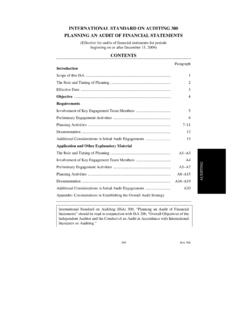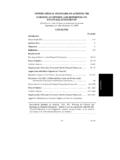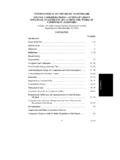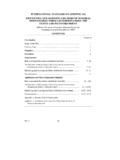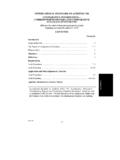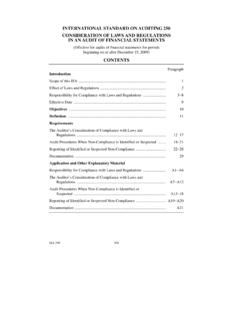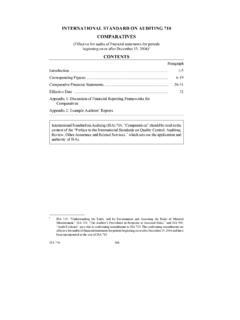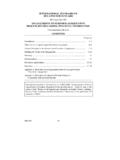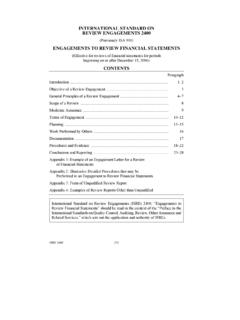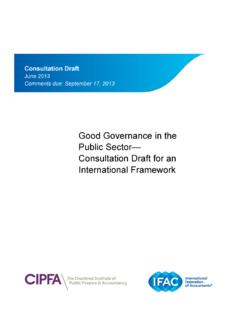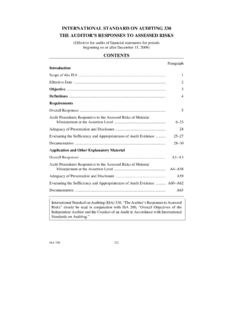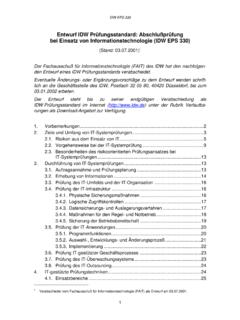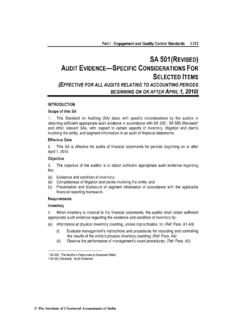Transcription of INTERNATIONAL STANDARD ON AUDITING 540 …
1 INTERNATIONAL STANDARD ON AUDITING 540. AUDITING ACCOUNTING ESTIMATES, INCLUDING FAIR. VALUE ACCOUNTING ESTIMATES, AND RELATED. DISCLOSURES. (Effective for audits of financial statements for periods beginning on or after December 15, 2009). CONTENTS. Paragraph Introduction Scope of this ISA .. 1. Nature of Accounting Estimates .. 2 4. Effective Date .. 5. Objective .. 6. Definitions .. 7. Requirements Risk Assessment Procedures and Related Activities .. 8 9. Identifying and Assessing the Risks of Material Misstatement .. 10 11. Responses to the Assessed Risks of Material Misstatement .. 12 14. Further Substantive Procedures to Respond to Significant Risks .. 15 17. Evaluating the Reasonableness of the Accounting Estimates, and Determining Misstatements .. 18. Disclosures Related to Accounting Estimates .. 19 20. Indicators of Possible Management Bias .. 21. Written Representations .. 22. Documentation .. 23. Application and Other Explanatory Material Nature of Accounting Estimates.
2 A1 A11. Risk Assessment Procedures and Related Activities .. A12 A44. Identifying and Assessing the Risks of Material Misstatement .. A45 A51. Responses to the Assessed Risks of Material Misstatement .. A52 A101. Further Substantive Procedures to Respond to Significant Risks .. A102 A115. ISA 540 458. AUDITING ACCOUNTING ESTIMATES, INCLUDING FAIR VALUE. ACCOUNTING ESTIMATES, AND RELATED DISCLOSURES. Evaluating the Reasonableness of the Accounting Estimates, and Determining Misstatements .. A116 A119. Disclosures Related to Accounting Estimates .. A120 A123. Indicators of Possible Management Bias .. A124 A125. Written Representations .. A126 A127. Documentation .. A128. Appendix: Fair Value Measurements and Disclosures under Different Financial Reporting Frameworks INTERNATIONAL STANDARD on AUDITING (ISA) 540, AUDITING Accounting Estimates, Including Fair Value Accounting Estimates, and Related Disclosures should be read in conjunction with ISA 200, Overall Objectives of the Independent Auditor and the Conduct of an Audit in Accordance with INTERNATIONAL standards on AUDITING .
3 AUDITING . 459 ISA 540. AUDITING ACCOUNTING ESTIMATES, INCLUDING FAIR VALUE. ACCOUNTING ESTIMATES, AND RELATED DISCLOSURES. Introduction Scope of this ISA. 1. This INTERNATIONAL STANDARD on AUDITING (ISA) deals with the auditor's responsibilities relating to accounting estimates, including fair value accounting estimates, and related disclosures in an audit of financial statements. Specifically, it expands on how ISA 3151 and ISA 3302 and other relevant ISAs are to be applied in relation to accounting estimates. It also includes requirements and guidance on misstatements of individual accounting estimates, and indicators of possible management bias. Nature of Accounting Estimates 2. Some financial statement items cannot be measured precisely, but can only be estimated. For purposes of this ISA, such financial statement items are referred to as accounting estimates. The nature and reliability of information available to management to support the making of an accounting estimate varies widely, which thereby affects the degree of estimation uncertainty associated with accounting estimates.
4 The degree of estimation uncertainty affects, in turn, the risks of material misstatement of accounting estimates, including their susceptibility to unintentional or intentional management bias. (Ref: Para. A1 A11). 3. The measurement objective of accounting estimates can vary depending on the applicable financial reporting framework and the financial item being reported. The measurement objective for some accounting estimates is to forecast the outcome of one or more transactions, events or conditions giving rise to the need for the accounting estimate. For other accounting estimates, including many fair value accounting estimates, the measurement objective is different, and is expressed in terms of the value of a current transaction or financial statement item based on conditions prevalent at the measurement date, such as estimated market price for a particular type of asset or liability. For example, the applicable financial reporting framework may require fair value measurement based on an assumed hypothetical current transaction between knowledgeable, willing parties (sometimes referred to as marketplace participants or equivalent) in an arm's length transaction, rather than the settlement of a transaction at some past or future 4.
5 A difference between the outcome of an accounting estimate and the amount originally recognized or disclosed in the financial statements does not necessarily represent a misstatement of the financial statements. This is particularly the case 1. ISA 315, Identifying and Assessing the Risks of Material Misstatement through Understanding the Entity and Its Environment.. 2. ISA 330, The Auditor's Responses to Assessed Risks.. 3. Different definitions of fair value may exist among financial reporting frameworks. ISA 540 460. AUDITING ACCOUNTING ESTIMATES, INCLUDING FAIR VALUE. ACCOUNTING ESTIMATES, AND RELATED DISCLOSURES. for fair value accounting estimates, as any observed outcome is invariably affected by events or conditions subsequent to the date at which the measurement is estimated for purposes of the financial statements. Effective Date 5. This ISA is effective for audits of financial statements for periods beginning on or after December 15, 2009. Objective 6. The objective of the auditor is to obtain sufficient appropriate audit evidence about whether: (a) accounting estimates, including fair value accounting estimates, in the financial statements, whether recognized or disclosed, are reasonable.
6 And (b) related disclosures in the financial statements are adequate, in the context of the applicable financial reporting framework. Definitions 7. For purposes of the ISAs, the following terms have the meanings attributed below: (a) Accounting estimate An approximation of a monetary amount in the absence of a precise means of measurement. This term is used for an amount measured at fair value where there is estimation uncertainty, as well as for other amounts that require estimation. Where this ISA. addresses only accounting estimates involving measurement at fair value, the term fair value accounting estimates is used. AUDITING . (b) Auditor's point estimate or auditor's range The amount, or range of amounts, respectively, derived from audit evidence for use in evaluating management's point estimate. (c) Estimation uncertainty The susceptibility of an accounting estimate and related disclosures to an inherent lack of precision in its measurement. (d) Management bias A lack of neutrality by management in the preparation of information.
7 (e) Management's point estimate The amount selected by management for recognition or disclosure in the financial statements as an accounting estimate. (f) Outcome of an accounting estimate The actual monetary amount which results from the resolution of the underlying transaction(s), event(s) or condition(s) addressed by the accounting estimate. 461 ISA 540. AUDITING ACCOUNTING ESTIMATES, INCLUDING FAIR VALUE. ACCOUNTING ESTIMATES, AND RELATED DISCLOSURES. Requirements Risk Assessment Procedures and Related Activities 8. When performing risk assessment procedures and related activities to obtain an understanding of the entity and its environment, including the entity's internal control, as required by ISA 315,4 the auditor shall obtain an understanding of the following in order to provide a basis for the identification and assessment of the risks of material misstatement for accounting estimates: (Ref: Para. A12). (a) The requirements of the applicable financial reporting framework relevant to accounting estimates, including related disclosures.
8 (Ref: Para. A13 . A15). (b) How management identifies those transactions, events and conditions that may give rise to the need for accounting estimates to be recognized or disclosed in the financial statements. In obtaining this understanding, the auditor shall make inquiries of management about changes in circumstances that may give rise to new, or the need to revise existing, accounting estimates. (Ref: Para. A16 A21). (c) How management makes the accounting estimates, and an understanding of the data on which they are based, including: (Ref: Para. A22 A23). (i) The method, including where applicable the model, used in making the accounting estimate; (Ref: Para. A24 A26). (ii) Relevant controls; (Ref: Para. A27 A28). (iii) Whether management has used an expert; (Ref: Para. A29vA30). (iv) The assumptions underlying the accounting estimates; (Ref: Para. A31 A36). (v) Whether there has been or ought to have been a change from the prior period in the methods for making the accounting estimates, and if so, why; and (Ref: Para.)
9 A37). (vi) Whether and, if so, how management has assessed the effect of estimation uncertainty. (Ref: Para. A38). 9. The auditor shall review the outcome of accounting estimates included in the prior period financial statements, or, where applicable, their subsequent re- estimation for the purpose of the current period. The nature and extent of the auditor's review takes account of the nature of the accounting estimates, and whether the information obtained from the review would be relevant to identifying and assessing risks of material misstatement of accounting 4. ISA 315, paragraphs 5 6 and 11 12. ISA 540 462. AUDITING ACCOUNTING ESTIMATES, INCLUDING FAIR VALUE. ACCOUNTING ESTIMATES, AND RELATED DISCLOSURES. estimates made in the current period financial statements. However, the review is not intended to call into question the judgments made in the prior periods that were based on information available at the time. (Ref: Para. A39 A44). Identifying and Assessing the Risks of Material Misstatement 10.
10 In identifying and assessing the risks of material misstatement, as required by ISA 315,5 the auditor shall evaluate the degree of estimation uncertainty associated with an accounting estimate. (Ref: Para. A45 A46). 11. The auditor shall determine whether, in the auditor's judgment, any of those accounting estimates that have been identified as having high estimation uncertainty give rise to significant risks. (Ref: Para. A47vA51). Responses to the Assessed Risks of Material Misstatement 12. Based on the assessed risks of material misstatement, the auditor shall determine: (Ref: Para. A52). (a) Whether management has appropriately applied the requirements of the applicable financial reporting framework relevant to the accounting estimate; and (Ref: Para. A53 A56). (b) Whether the methods for making the accounting estimates are appropriate and have been applied consistently, and whether changes, if any, in accounting estimates or in the method for making them from the prior period are appropriate in the circumstances.
